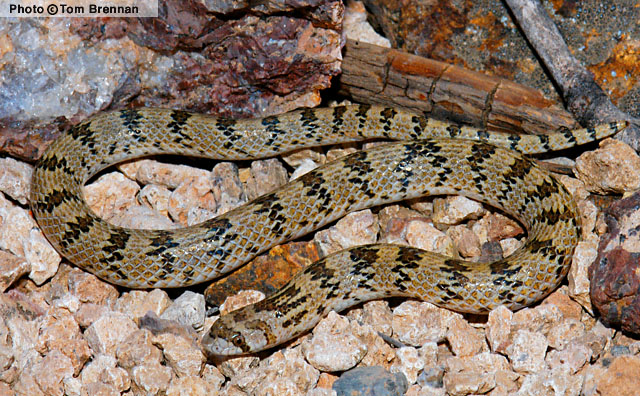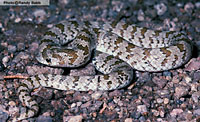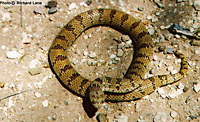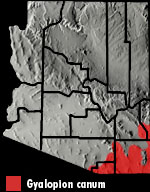Online Field Guide to The Reptiles and Amphibians of Arizona



Santa Cruz County, Arizona
 Cochise Co., AZ |
Cochise Co., AZ
|
| CHIHUAHUAN HOOK-NOSED SNAKE Gyalopion canum |
Non-Venomous
|
| DESCRIPTION: A small (up to 380 mm or 15″ in total length), relatively stout-bodied, gray, yellow-brown, or tan colored snake with more than 25 dark gray or brown, zigzag shaped bars across the back. A brown or gray-brown mask crosses the top of the head and covers the eyes on most specimens. The underside is pale or white, often with a pinkish or salmon tint. The pupils are round. The scales are smooth. The snout (rostral scale) is upturned on the leading edge and flat or concave on top.
DISTRIBUTION: This snake occurs in the foothills, bajadas, and valleys of southeastern Arizona at elevations below approximately 6,000′. HABITAT: It is primarily associated with Chihuahuan Desertscrub and Semidesert Grassland communities but it is also encountered in Madrean Evergreen Woodland. In Arizona this snake is most frequently encountered on gentle sloping bajadas or in low foothills with rocky or gravelly soil grown with creosotebush or grasses. It is also occasionally encountered in the lower reaches of mountainous terrain along ridges and in canyons. DIET: The Chihuahuan Hook-nosed Snake feeds on small spiders, insects, centipedes, and scorpions. Captive specimens have also eaten snakes, lizards, and small mice. REPRODUCTION: A clutch of up to 4 eggs is laid in late spring or early summer. Brennan, T. C., and A. T. Holycross. 2006. A Field Guide to Amphibians and Reptiles in Arizona. Arizona Game and Fish Department. Phoenix, AZ Degenhardt, W. G., Painter, C. W., and Price, A. H.. 1996. Amphibians and Reptiles of New Mexico. University of New Mexico Press. Albuquerque. Fowlie. 1965. The Snakes of Arizona. Azul Quinta Press, Fallbrook, California Stebbins. 1985. Western Reptiles and Amphibians. Houghton Mifflin. New York, NY |
|
Visit Partners in Amphibian and Reptile Conservation:


HOME
Copyright © 2023, Arizona Game and Fish Department. All rights reserved.
If you make use of the textual contents of this site in reports, publications, etc. please cite and credit the author(s) and photographer(s). All photos on this website are copyrighted. However, those found in the species account section may be used for any noncommercial scientific, educational, or conservation purposes provided that photographs are not altered and continue to bear the copyright symbol and name of the photographer. Please contact the photographer regarding commercial use of copyrighted photographs.











